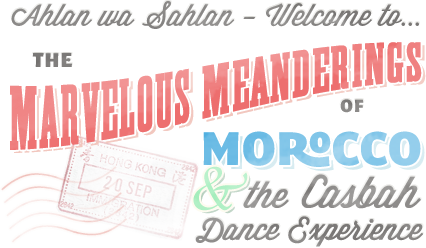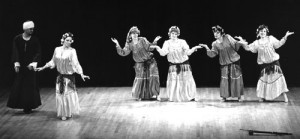The definitive guide – and a book more entertaining than many performances!, May 2, 2012 By Shantimar (Athens, Greece)
This review is for: You Asked Aunt Rocky: Answers & Advice About Raqs Sharqi and Raqs Shaabi (Perfect Paperback)
You can almost hear your mind’s doors screeching open while reading this book.
She’s been around for the last half-century or so, dancing, learning, travelling, teaching, arguing with people, fighting – at times single-handedly – a noble cause in the name of oriental dance.
Although the deluge of cheap, fake, stupid or downright sleazy dancers and shows threatens to drown Morocco’s voice, this only strengthens her determination to inform the public about what oriental dance really is, to help dancers understand what it is they are dancing, to make them want to learn more, investigate, and not blindly accept whatever their teacher or their neighbours think. To make them more conscious artists, women and human beings. By propagating the consideration for the culture and knowledge about the dance’s history, by being more respectful to their dance, they will get more respect themselves, and their life and work will become more meaningful.
I first met Morocco (Aunt Rocky) online, on that defunct M.E.D. List, and absorbed with relish all she had to say, which often was a revelation to me. That’s why I consider her one of my most important teachers, although I’ve never taken an actual lesson with her (apart from a weekend seminar, but that was choreographies). And, in that sense, she might also be considered the teacher of my own students, since I’m now passing on the information. As well as admiration and respect for this amazing woman: an intelligent, passionate, opinionated, resourceful, creative, thorough, and immensely funny lady whom I love from the bottom of my heart and I’ll always feel close to, even if I should never meet her again in my life. She has been a tremendous influence for me as for uncountable others, and I feel I’ve become richer (only in the figurative sense, though, LOL) because of her being in this world.
Still, as much as she’s been teaching, in her studio, in online lists and articles,conferences and in innumerable seminars abroad, how many can have access to her teachings and benefit from her huge experience? And – touch wood! – will she be around forever? Who can pass on all of that knowledge to the next generation of dancers? We all have some bits, but only she has the whole thing.
That’s why a book was a necessity. The organizing of such vast material must have seemed a huge chore to someone who is not a professional writer, so the format chosen was a clever way out. An introduction to the chapter or subchapter, and then a Q and A, based on the saved email exchanges that we lovingly remember. Plus filling up on whatever subjects hadn’t been covered on the list, inserting stories, anecdotes, even full articles and interviews.
She does cover almost everything one would ever wish to know about the subject – including some things we didn’t know we wished to know, and a huge chunk of info on folkloric dances (she calls it raqs Shaabi, not to be confused with the urban Shaabi style) which have little to do with Oriental dance and thus will surely not be of much interest to at least half of the dancers. But it had to be there, as so many dancers and show organizers now are seeking, for variety’s sake, to include some of them in their performances. Being a relatively new addition, it is a candidate of mis-interpretation, and as such, a candidate of Morocco’s saving campaign.
Here is what you’ll find in the book:
1. It starts with an introduction and a short biography – too short in my opinion, but maybe she’s saving the juicy parts for a separate book, who knows?
2 and 3. The two chapters about Shaabi (folk dances) and Sharqi/Oryantal. Discussing the different styles, what is done where, what is authentic and what is invented, giving definitive answers. When she talks about Taheya Carioca and how she got her name, it’s Carioca herself who told her. When she says that Mahmoud Reda invented Melaya Leff, it’s from Reda’s lips that she has it. And so on. So you can relax and be sure, and read on, knowing that you can trust completely what you read.
4. The next chapter, “Over There”, is very useful. What is happening in the countries of origin of the dance? How is the situation now, how are they thinking about the dance, what are the conditions for dancers? Where to go, how to act, what to expect, what to shop for if you want to travel there?
5. The next chapter is called “Nuts and Bolts” and is divided into Teaching, Techniques, Finger Cymbals and Working. No, it does not teach you technique, but it does give invaluable pointers, and discusses most issues that people will come across as students, teachers and/or professionals, including what to look for in a good teacher, a safe position of the hands when playing finger cymbals to avoid tendinitis at this age of PC use, whether and how to accept tips, how to organize a seminar and so on.
6. The Cautionary Tales, Personal Encounters and Revelations will help you be wary of and avoid the many pitfalls in your way, but also flesh out the scant biography section because here she recounts her meetings with great dancers/choreographers or people relevant to the dance history.
7. What’s in a name? A lot, according to Morocco, and it’s because of her, mainly, that so many of us are avoiding the offensive “b” word in favour of Raqs Sharqi or its translation, Oriental dance – even if we all use them in the tags of our youtube videos and in the keywords of our websites, well knowing that the public will usually not search for the politically correct name but for the misnomer.
8. Images. A few pictures, some never previously available to the general public, with the authentic costuming of folk dances.
9. Glossary. Indispensable, even the most knowledgeable will find a word he/she didn’t know.
10. Bibliography. A very fat bibliography, 5,5 big pages long, containing old print classics but also some web resources and videos.
11. Index. Very useful, considering the wealth of material in the book.
12. About the Author. All the awards and recognitions and nice things that she couldn’t put in her bio written in the first person.
So, a really comprehensive reference book. What I didn’t mention is that, while being exact and scholarly, it’s exceptionally well-written, pleasant, witty and to the point, even anectodes are no idle chat, they have a reason of being there. It has the flavour of real conversation, and goes down sweetly, so that even non-bookish dancers will enjoy perusing at least parts of it, if the size of it doesn’t feel threatening to them. So yes, even if you haven’t ever read anything other than Cosmo in your life, don’t hesitate, give it a go, you’ll not regret it!

